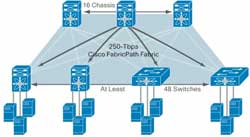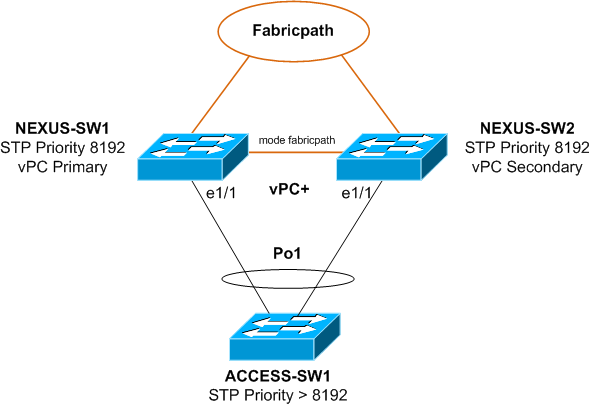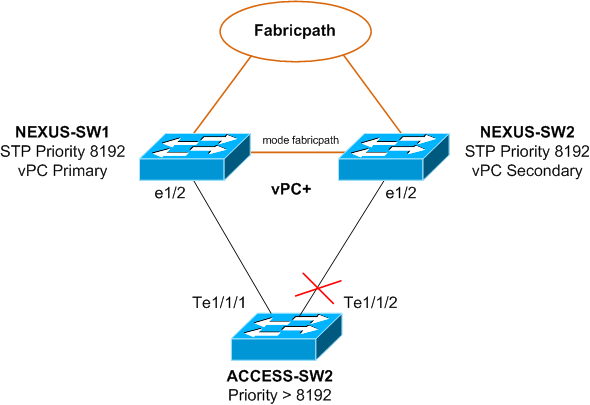 If you are familiar with Nexus vPC configuration, you might have been setting different STP priority on the primary and secondary switches so the primary is always a STP root, and have that lined up with, for example, HSRP active node. With vPC+ (ie. running vPC on a pair of switches that participate in fabricpath), the two Nexus switches appear as a single logical switch to both fabricpath cloud and upstream/downstream vPC switches, so it is actually crucial to make sure the upstream/downstream vPC switches receive consistent STP root priority regardless of which path is active. In this article, we demonstrate the importance of setting identical STP priority on the vPC+ peer switches, how the switches react when a superior BPDU is received, and other implications using Cisco Nexus 5000.
If you are familiar with Nexus vPC configuration, you might have been setting different STP priority on the primary and secondary switches so the primary is always a STP root, and have that lined up with, for example, HSRP active node. With vPC+ (ie. running vPC on a pair of switches that participate in fabricpath), the two Nexus switches appear as a single logical switch to both fabricpath cloud and upstream/downstream vPC switches, so it is actually crucial to make sure the upstream/downstream vPC switches receive consistent STP root priority regardless of which path is active. In this article, we demonstrate the importance of setting identical STP priority on the vPC+ peer switches, how the switches react when a superior BPDU is received, and other implications using Cisco Nexus 5000.
Below are a diagram, switch vPC configuration, and show-command outputs when everything is configured properly. Here the downstream switch ACESS-SW1 is connecting via port-channel 1 to the Nexus switches. Vlan 2 and 10 are in mode fabricpath, while vlan 20 and 21 are Classical Ethernet. A few things to note are:
-
Both Nexus switches uses a virtual MAC address (c84c.75ec.8000) as their STP ID instead of the respective VLAN interface MAC address (547f.eeaf.78dc and 547f.eeaf.97ca) for VLAN that are in mode fabricpath
-
Nexus switches continue to use the actual VLAN interface MAC address for the Classical Ethernet VLAN.
-
Both Nexus switches claim to be STP root
-
There is no STP running over peer-link as they are configured as ‘switchport mode fabricpath’, while Po1 still runs STP
-
Both Nexus switches require identical fabricpath (virtual) switch ID, which is advertised to the fabricpath cloud along with their individual fabricpath switch ID

|
************** Configuration **************
!--------- NEXUS-SW1 ---------
spanning-tree vlan 1-4093 priority 8192
!
vpc domain 1
role priority 8192
system-priority 8192
peer-keepalive destination 192.168.0.1 source 192.168.0.2 vrf KEEPALIVE
fabricpath switch-id 1
!
!--------- NEXUS-SW2 --------
spanning-tree vlan 1-4093 priority 8192
!
vpc domain 1
role priority 16384
system-priority 8192
peer-keepalive destination 192.168.0.2 source 192.168.0.1 vrf KEEPALIVE
fabricpath switch-id 1
!
************** Show Outputs **************
!--------- NEXUS-SW1 ---------
NEXUS-SW1# sh int vl 10
Vlan10 is up, line protocol is up
Hardware is EtherSVI, address is 547f.eeaf.78dc
Description: *** VLAN10 ***
Internet Address is 172.16.10.2/24
MTU 1500 bytes, BW 1000000 Kbit, DLY 10 usec
NEXUS-SW1# sh spann root
Root Hello Max Fwd
Vlan Root ID Cost Time Age Dly Root Port
---------------- -------------------- ------- ----- --- --- ----------------
VLAN0002 8194 c84c.75ec.8000 0 2 20 15 This bridge is root <-- Virtual MAC
VLAN0010 8202 c84c.75ec.8000 0 2 20 15 This bridge is root
VLAN0020 8212 547f.eeaf.78dc 0 2 20 15 This bridge is root <-- Real MAC
!
NEXUS-SW1# sh spann vl 10
VLAN0010
Spanning tree enabled protocol rstp
Root ID Priority 8202
Address c84c.75ec.8000
This bridge is the root
Hello Time 2 sec Max Age 20 sec Forward Delay 15 sec
Bridge ID Priority 8202 (priority 8192 sys-id-ext 10)
Address c84c.75ec.8000
Hello Time 2 sec Max Age 20 sec Forward Delay 15 sec
Interface Role Sts Cost Prio.Nbr Type
---------------- ---- --- --------- -------- --------------------------------
Po1 Desg FWD 1 128.4096 (vPC) P2p <-- No STP over Peer-Link
!
!
NEXUS-SW1# sh fabricpath switch-id
FABRICPATH SWITCH-ID TABLE
Legend: '*' - this system
=========================================================================
SWITCH-ID SYSTEM-ID FLAGS STATE STATIC EMULATED
----------+----------------+------------+-----------+--------------------
1 547f.eeaf.97ca Primary Confirmed No Yes <-- Virtual Switch ID
1 547f.eeaf.78dc Primary Confirmed No Yes <-- Virtual Switch ID
*2 547f.eeaf.78dc Primary Confirmed Yes No <-- Individual Switch ID
3 547f.eeaf.97ca Primary Confirmed Yes No
!--------- NEXUS-SW2 --------
NEXUS-SW2# sh int vl 10
Vlan10 is up, line protocol is up
Hardware is EtherSVI, address is 547f.eeaf.97ca
Description: *** VLAN10 ***
Internet Address is 172.16.10.3/24
MTU 1500 bytes, BW 1000000 Kbit, DLY 10 usec
!
NEXUS-SW2# sh spann roo
Root Hello Max Fwd
Vlan Root ID Cost Time Age Dly Root Port
---------------- -------------------- ------- ----- --- --- ----------------
VLAN0002 8194 c84c.75ec.8000 0 2 20 15 This bridge is root <-- Virtual MAC
VLAN0010 8202 c84c.75ec.8000 0 2 20 15 This bridge is root
VLAN0021 8213 547f.eeaf.97ca 0 2 20 15 This bridge is root <-- Real MAC
NEXUS-SW2# sh spann vl 10
VLAN0010
Spanning tree enabled protocol rstp
Root ID Priority 8202
Address c84c.75ec.8000
This bridge is the root
Hello Time 2 sec Max Age 20 sec Forward Delay 15 sec
Bridge ID Priority 8202 (priority 8192 sys-id-ext 10)
Address c84c.75ec.8000
Hello Time 2 sec Max Age 20 sec Forward Delay 15 sec
Interface Role Sts Cost Prio.Nbr Type
---------------- ---- --- --------- -------- --------------------------------
Po1 Desg FWD 1 128.4096 (vPC) P2p <-- No STP over Peer-Link
|
Scenario 1: Better BPDU received from downstream vPC switch
When we configure ACCESS-SW1 with better STP priority on VLAN 10, the followings were observed.
-
Both Nexus switches becomes blocking with error ‘*L2GW_Inc’ on interface Po1 VLAN 10
-
After restoring the STP priority on ACCESS-SW1, the Nexus switches transition to ‘*LOOP_Inc’
-
Po1 on the ACCESS-SW1 side needs to ‘shut’ and ‘no shut’ for VLAN 10 STP on the Nexus to return to forwarding state
This behavior is a result of the requirement that vPC+ peer switches need to be STP root on all VLAN that are in mode fabricpath.
|
************** Configuration **************
!-------- ACCESS-SW1 ------
spanning-tree vlan 10 priority 4096
!
************** Show Outputs **************
!--------- NEXUS-SW1 ---------
NEXUS-SW1# sh spann vl 10
VLAN0010
Spanning tree enabled protocol rstp
Root ID Priority 8202
Address c84c.75ec.8000
This bridge is the root
Hello Time 2 sec Max Age 20 sec Forward Delay 15 sec
Bridge ID Priority 8202 (priority 8192 sys-id-ext 10)
Address c84c.75ec.8000
Hello Time 2 sec Max Age 20 sec Forward Delay 15 sec
Interface Role Sts Cost Prio.Nbr Type
---------------- ---- --- --------- -------- --------------------------------
Po1 Desg BKN*1 128.4096 (vPC) P2p *L2GW_Inc
NEXUS-SW1# sh spann vl 10
VLAN0010
Spanning tree enabled protocol rstp
Root ID Priority 8202
Address c84c.75ec.8000
This bridge is the root
Hello Time 2 sec Max Age 20 sec Forward Delay 15 sec
Bridge ID Priority 8202 (priority 8192 sys-id-ext 10)
Address c84c.75ec.8000
Hello Time 2 sec Max Age 20 sec Forward Delay 15 sec
Interface Role Sts Cost Prio.Nbr Type
---------------- ---- --- --------- -------- --------------------------------
Po1 Desg BKN*1 128.4096 (vPC) P2p *LOOP_Inc
|
Scenario 2: Dual-homed downstream switch with no vPC
Here we have ACCESS-SW2 that is dual-connected to both Nexus but no running etherchannel. We then change the STP priority on NEXUS-SW2 to 16384. The followings were observed.
-
Ethernet1/2 on NEXUS-SW2 changes STP state to blocking with error ‘*L2GW_Inc’
Because ACCESS-SW2 is not dual-connected with vPC, the BPDU it receives from NEXUS-SW1 was accepted on Te1/1/1 (as it has priority of 8192) and advertised out Te1/1/2 to NEXUS-SW2. Since NEXUS-SW2 is running vPC+, it would not accept any superior BPDU, hence putting the interface in STP blocking.

|
************** Before Changes **************
!--------- NEXUS-SW1 ---------
NEXUS-SW1# sh spann vl 2
VLAN0002
Spanning tree enabled protocol rstp
Root ID Priority 8194
Address c84c.75ec.8000
This bridge is the root
Hello Time 2 sec Max Age 20 sec Forward Delay 15 sec
Bridge ID Priority 8194 (priority 8192 sys-id-ext 2)
Address c84c.75ec.8000
Hello Time 2 sec Max Age 20 sec Forward Delay 15 sec
Interface Role Sts Cost Prio.Nbr Type
---------------- ---- --- --------- -------- --------------------------------
Eth1/2 Desg FWD 2 128.141 P2p
!--------- NEXUS-SW2 ---------
NEXUS-SW2# sh spann vl 2
VLAN0002
Spanning tree enabled protocol rstp
Root ID Priority 8194
Address c84c.75ec.8000
This bridge is the root
Hello Time 2 sec Max Age 20 sec Forward Delay 15 sec
Bridge ID Priority 8194 (priority 8192 sys-id-ext 2)
Address c84c.75ec.8000
Hello Time 2 sec Max Age 20 sec Forward Delay 15 sec
Interface Role Sts Cost Prio.Nbr Type
---------------- ---- --- --------- -------- --------------------------------
Eth1/2 Desg FWD 2 128.141 P2p
!---------- ACCESS-SW2 ----------------
ACCESS-SW2#sh spann vlan 2
VLAN0002
Spanning tree enabled protocol rstp
Root ID Priority 8194
Address c84c.75ec.8000
Cost 2
Port 53 (TenGigabitEthernet1/1/1)
Hello Time 2 sec Max Age 20 sec Forward Delay 15 sec
Bridge ID Priority 32770 (priority 32768 sys-id-ext 2)
Address 30f7.0d4e.56fa
Hello Time 2 sec Max Age 20 sec Forward Delay 15 sec
Aging Time 300 sec
Interface Role Sts Cost Prio.Nbr Type
------------------- ---- --- --------- -------- --------------------------------
Te1/1/1 Root FWD 2 128.53 P2p
Te1/1/2 Altn BLK 2 128.54 P2p
************** Configuration **************
!--------- NEXUS-SW2 ---------
spann vlan 2 prio 16384
!
************** After Changes **************
!--------- NEXUS-SW2 ---------
NEXUS-SW2# sh spann vl 2
VLAN0002
Spanning tree enabled protocol rstp
Root ID Priority 16386
Address c84c.75ec.8000
This bridge is the root
Hello Time 2 sec Max Age 20 sec Forward Delay 15 sec
Bridge ID Priority 16386 (priority 16384 sys-id-ext 2)
Address c84c.75ec.8000
Hello Time 2 sec Max Age 20 sec Forward Delay 15 sec
Interface Role Sts Cost Prio.Nbr Type
---------------- ---- --- --------- -------- --------------------------------
Eth1/2 Desg BKN*2 128.141 P2p *L2GW_Inc
|
Scenario 3: Controlling active link for dual-homed non-vpc switch
Now that the Nexus switches appear as a single switch, with everything in BPDU being equal, by default, ACCESS-SW2 would break the tie by STP port ID. If you want to have control over which link is forwarding, you can define STP port-priority on the NEXUS-SW1 or NEXUS-SW2 interface Ethernet1/2 and the one with lower priority will cause the corresponding interface on ACCESS-SW2 to forward.
Here, interface Te1/1/1 is forwarding by default. We will lower the port-priority on Ethernet 1/2 of NEXUS-SW2 down to 64 (default is 128). Te1/1/2 subsequently becomes forwarding and Te1/1/1 went into blocking.
|
************** Configuration **************
!--------- NEXUS-SW2 ---------
int e1/2
spanning-tree port-priority 64
!
************** Show Outputs **************
!----------ACCESS-SW2 ----------------
ACCESS-SW2#sh spann vl 2
VLAN0002
Spanning tree enabled protocol rstp
Root ID Priority 8194
Address c84c.75ec.8000
Cost 2
Port 54 (TenGigabitEthernet1/1/2)
Hello Time 2 sec Max Age 20 sec Forward Delay 15 sec
Bridge ID Priority 32770 (priority 32768 sys-id-ext 2)
Address 30f7.0d4e.56fa
Hello Time 2 sec Max Age 20 sec Forward Delay 15 sec
Aging Time 300 sec
Interface Role Sts Cost Prio.Nbr Type
------------------- ---- --- --------- -------- --------------------------------
Te1/1/1 Altn BLK 2 128.53 P2p
Te1/1/2 Root FWD 2 128.54 P2p
!
|
References: Cisco Nexus 5000 Series NX-OS FabricPath Configuration Guide, Release 5.1(3)N1(1)
 If you are familiar with Nexus vPC configuration, you might have been setting different STP priority on the primary and secondary switches so the primary is always a STP root, and have that lined up with, for example, HSRP active node. With vPC+ (ie. running vPC on a pair of switches that participate in fabricpath), the two Nexus switches appear as a single logical switch to both fabricpath cloud and upstream/downstream vPC switches, so it is actually crucial to make sure the upstream/downstream vPC switches receive consistent STP root priority regardless of which path is active. In this article, we demonstrate the importance of setting identical STP priority on the vPC+ peer switches, how the switches react when a superior BPDU is received, and other implications using Cisco Nexus 5000.
If you are familiar with Nexus vPC configuration, you might have been setting different STP priority on the primary and secondary switches so the primary is always a STP root, and have that lined up with, for example, HSRP active node. With vPC+ (ie. running vPC on a pair of switches that participate in fabricpath), the two Nexus switches appear as a single logical switch to both fabricpath cloud and upstream/downstream vPC switches, so it is actually crucial to make sure the upstream/downstream vPC switches receive consistent STP root priority regardless of which path is active. In this article, we demonstrate the importance of setting identical STP priority on the vPC+ peer switches, how the switches react when a superior BPDU is received, and other implications using Cisco Nexus 5000.


